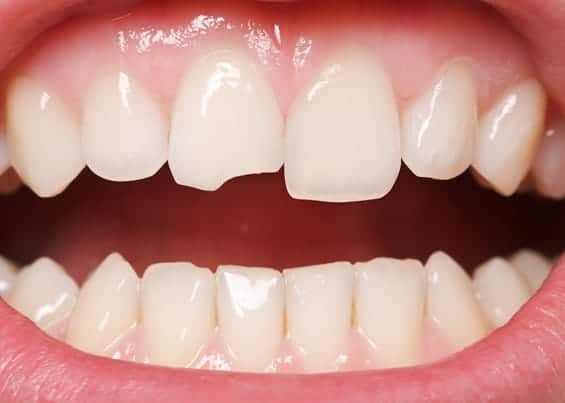Is it a Chipped or Cracked Tooth?
Chipped Tooth:
If you have a chipped tooth, you might not feel any tooth pain unless the chip is large enough to expose the nerves in the inner layer of the tooth. If a chipped tooth exposes the nerves inside a tooth, you might notice increased tooth sensitivity and pain when chewing or when the chipped tooth is exposed to very hot or very cold food and beverages.

A chip on one of the pointed chewing surfaces of the back teeth is called a broken cusp. This type of chipped tooth is rarely painful, but it should be examined by a dental professional. You might need a crown or a dental onlay to restore the shape of the tooth and prevent further damage or decay.
Cracked Tooth:
A cracked tooth might affect only the tooth enamel, or it might affect the entire tooth down to the root. You might only notice pain from a cracked tooth when chewing, or when the temperature in your mouth changes as you eat something hot or cold. But it is important to see a dental professional as soon as possible after you notice a cracked tooth, so it can be evaluated and treated if necessary.
Chipped Tooth Treatments
Small Chip: If the chip in your tooth is very small, your dental professional might simply smooth and polish the chipped tooth, and no additional treatment will be needed.
Medium Chip: If your chipped tooth involves minor damage to the tooth enamel, your dental professional will probably place a filling, crown, or cap over the chipped tooth to restore its normal appearance and function and to protect the inner layers of the teeth from irritation and infection.
Large Chip: If your chipped tooth is large enough to expose the tooth nerve, you will likely need a root canal to remove the damaged nerve, plus a crown or cap to replace the chipped tooth.
Cracked Tooth Treatments
Simple Cracked Tooth: Simple cracks in the tooth enamel are also known as “craze lines.” This type of cracked tooth may not require treatment, but you should still see a dental professional for evaluation. Your dental professional can polish the cracked tooth to smooth rough spots and improve the tooth’s appearance.
Serious Cracked Tooth: If you have a serious cracked tooth, the fracture could extend from the chewing surface of the tooth down into the tooth root. If you have a serious cracked tooth that goes through the outer layers of tooth enamel and dentin to exposes the tooth pulp, the tooth can become loose and your gums may bleed.
Split Tooth: In some cases, a cracked tooth splits vertically. If this occurs in one of your molars, your dental professional may be able to salvage one of the two tooth roots that molars have. If the root is too badly damaged, you will need to have the tooth removed and replaced. Split Root: A cracked tooth can also start in the tooth root. This type of cracked tooth is obvious and painful, and it can cause inflammation and infection at the tooth root that often leaves tooth extraction as the only treatment.
